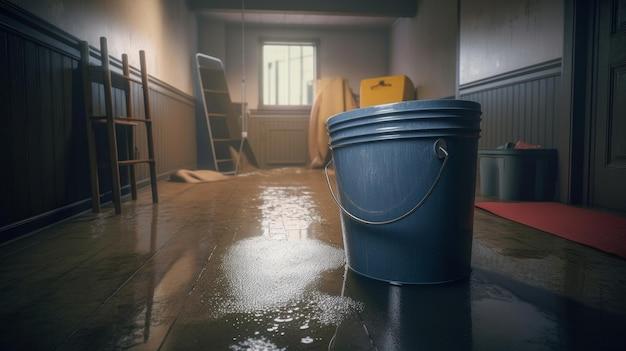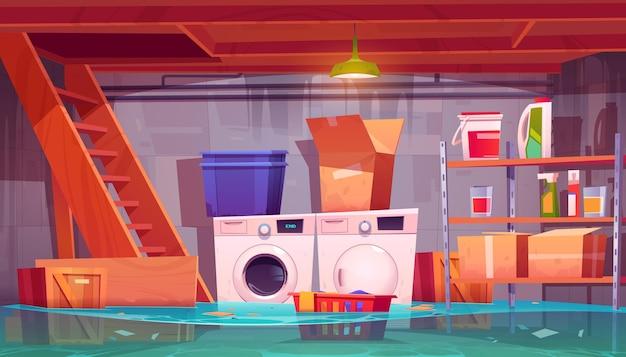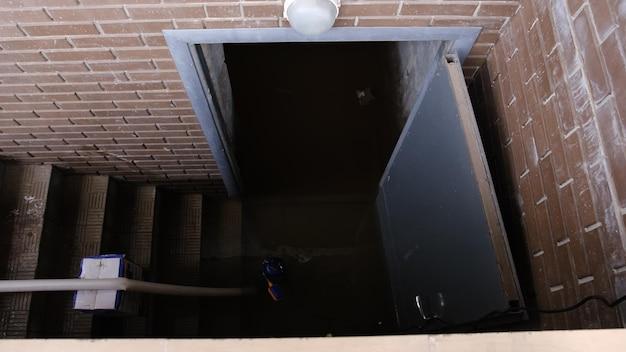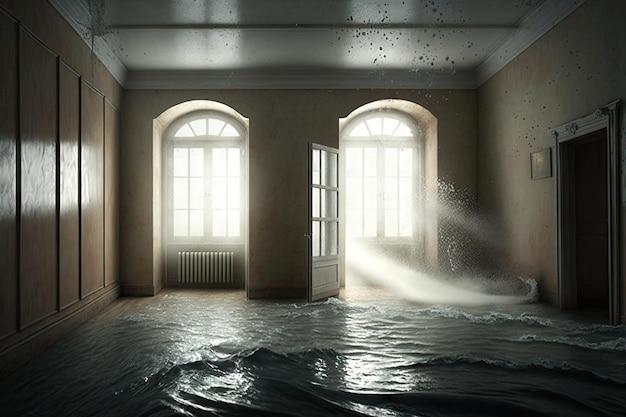If you’ve ever experienced a flooded basement due to a hot water heater malfunction, then you know how stressful and unpleasant it can be. Not only do you have to deal with the water damage, but you also have to worry about your expensive hot water heater. Many homeowners find themselves asking questions such as “why did my water heater flood” or “what to do when water heater flooded”.
In this comprehensive blog post, we’ll explore all the possible reasons why your hot water heater may be flooding your basement. We’ll also dive into the most common causes of flooded water heater pilot light, and whether a basement flood can ruin a water heater. We will provide you with detailed steps you can take to address this issue, including how to drain a hot water heater in the basement.
We’ll also answer questions such as “what happens if water heater gets wet” and “how long does it take for a hot water heater to dry out”. Furthermore, we will explore why your gas water heater may not be working after it has rained, so that you can understand the root cause of the problem.
By the end of this article, you’ll have all the information you need to deal with a flooded hot water heater in your basement. So let’s dive in and learn how to deal with this unpleasant situation.
Why Did My Water Heater Flood
A flooded basement can be a homeowner’s worst nightmare, and when it’s caused by a water heater, it can be especially frustrating. But why did your water heater flood in the first place? Here are a few possible reasons:
Plumbing Leaks
One of the most common reasons for a water heater flood is plumbing leaks. Leaking pipes can cause water to accumulate around the base of the heater, eventually leading to a flood. If you suspect a leak, it’s important to call a plumber as soon as possible to identify the problem and make repairs.
Sediment Buildup
Over time, sediment can build up in your water heater tank, which can cause the tank to corrode and eventually spring a leak. When this happens, water can escape from the tank and flood your basement. To prevent sediment buildup, it’s a good idea to flush your water heater tank regularly according to the manufacturer’s instructions.
Faulty Pressure Relief Valve
Every water heater has a pressure relief valve that is designed to relieve excess pressure in the tank. If the valve fails, pressure can build up and cause the tank to rupture, leading to a flood. It’s important to have your pressure relief valve checked regularly to ensure that it’s functioning properly.
Improper Installation
If your water heater was not installed correctly, it may be more prone to leaks and floods. This is why it’s crucial to have your water heater installed by a professional who is experienced in hot water heater installation.
Overall, there are a few reasons why your water heater might flood your basement. By understanding the common causes of water heater floods, you can take steps to prevent them and ensure that your basement stays dry and comfortable.
Flooded Water Heater Pilot Light
One of the most common problems that people experience with their hot water heaters is a flooded pilot light. This usually happens when water gets into the unit through a leak or a broken valve, and it can prevent the heater from working effectively.
Signs of a Flooded Pilot Light
If you think you may have a flooded pilot light, there are a few signs you can look for. Firstly, you may notice that your hot water is not as hot as usual, or that it runs out faster than it should. You may also see puddles of water around the base of the heater or hear strange noises coming from the unit.
What to Do if Your Pilot Light is Flooded
If you suspect that your pilot light is flooded, the first thing you should do is turn off the power to the unit. This will prevent any further damage from occurring. Next, drain the tank completely and remove the heater’s access panel to see if you can locate the source of the flood.
If the problem is a leak or a broken valve, you may need to call in a professional plumber to fix the issue. In some cases, you may need to replace the entire heater if the damage is severe.
Preventing Pilot Light Flooding
To prevent your pilot light from flooding in the first place, it is important to perform regular maintenance on your hot water heater. This includes checking for leaks or cracks in the unit, cleaning the tank, and replacing any worn out parts.
You should also make sure that your heater is installed on a level surface and that there are no obstructions around the unit. This will prevent water from pooling around the base of the heater and flooding the pilot light.
In conclusion, a flooded pilot light can be a frustrating and potentially dangerous problem for homeowners. By understanding the signs of a flooded pilot light, knowing what to do if it happens, and taking steps to prevent it from occurring in the first place, you can ensure that your hot water heater remains in good working order for years to come.
What to Do When Your Water Heater Floods
If you’re unlucky enough to experience a flooded basement due to a malfunctioning hot water heater, don’t panic. Here are some steps you can take to address the situation calmly and efficiently.
Turn Off the Power and Water Supply
The first thing to do when you notice a flooded basement is to turn off the power and water supply. This will help prevent any further damage and ensure your safety. If you’re unsure how to do this, contact a professional plumber or electrician to assist you.
Assess the Damage
Once you’ve turned off the power and water supply, take a closer look at the extent of the damage. Is the water level high enough to damage your furniture or other possessions? If so, quickly remove them from the affected area. If the water level is too high or you’re not sure how to proceed, it’s best to call a professional.
Start Cleanup
Begin the cleanup process by removing any standing water with a wet/dry vacuum or a mop and bucket. Next, use fans or a dehumidifier to dry out the area. You can also open windows and doors to improve air circulation and speed up the drying process.
Contact Your Insurance Company
If you have homeowner’s insurance, contact your insurance company as soon as possible to report the damage. They can direct you to local professionals who can assist you with cleanup and repair.
Replace or Repair Your Water Heater
Finally, it’s time to replace or repair your water heater. This should only be done by a licensed professional plumber. They can advise you on the best course of action and ensure your new heater is properly installed and working correctly.
Remember, dealing with a flooded basement can be stressful, but following these simple steps can help you stay calm and resolve the situation quickly.
What Happens If A Water Heater Gets Wet
If you have a flooded basement, one of the things you’re likely concerned about is the state of your hot water heater, especially if it’s located in your basement. A water heater can become damaged if it gets wet or submerged in water. In this section, we’ll discuss what happens if a water heater gets wet and the steps you need to take.
Water Heater Damage
Water heaters are not designed to be submerged in water. If your water heater gets wet, it can cause significant damage to the unit, including:
- Corrosion: Water heaters can corrode quickly if they’re submerged in water. Corrosion can cause leaks and reduce the lifespan of the unit.
- Electrical Damage: If water gets into the electrical components of the unit, it can damage the wiring, thermostat, and other electrical components. It may also create a short circuit or electrocution hazard.
- Contaminated Water: If the floodwater is contaminated, it can flow back into your water heater and contaminate your hot water supply.
Steps To Take
If your water heater gets wet, you need to take steps to prevent it from causing further damage. Here’s what you need to do:
- Turn Off Power: Turn off the power to the water heater. If you’re not sure how to do this, turn off the power to your entire home.
- Turn Off Water Supply: Turn off the water supply to the water heater.
- Drain The Water Heater: Attach a hose to the drain valve at the bottom of the unit and drain the water heater completely. This will remove any remaining water from the unit.
- Let it Dry: Let the unit dry completely before attempting to turn it back on. You can use a fan or dehumidifier to speed up the drying process.
In conclusion, if your water heater gets wet, it can cause significant damage to the unit. To prevent further damage, turn off the power and water supply, drain the water heater, and let it dry completely. If you’re not comfortable doing this yourself, contact a professional plumber for assistance. Don’t attempt to turn your water heater back on until it has completely dried out.
Gas Water Heater Not Working after Rain
If you have a gas water heater at home, you know how frustrating it can be when it suddenly stops working. Even more frustrating is when it stops working after a heavy rain. Here’s what you need to know and how to troubleshoot it.
Check for Water Damage
Heavy rain can result in flooded basements, and if your gas water heater is in the basement, it may have been affected by the water. Before you do anything else, inspect the heater for water damage. If you see water pooling around the base of the heater or rusted areas, this is a sign that water has gotten into the heater. This could be due to a loose connection or a crack in the tank. It is important to turn off the gas and power supply to the water heater if you find any signs of water damage.
Inspect the Pilot Light
If you find no signs of water damage, check the pilot light. Check if it was blown out by the rain or wind. If it is out, follow the manufacturer’s instructions to relight the pilot. However, if you continue to have problems lighting the pilot or if it keeps going out, this could be due to the excessive moisture in the air which is impacting the pilot light. You may need to call a Gas Safe registered specialist plumber or engineer to get it fixed.
Test the Thermostat
If the pilot light is not the problem, it may be the thermostat. Check the thermostat setting if it is set too low or too high. Ensure the temperature is set at the right level. If the thermostat is not responding, you may need to get it checked or replaced.
Check for Gas Supply
Another possibility is that your gas supply may have been interrupted during the rain. Check the valve going to the gas supply to the heater is switched on. If not, turn it on and try restarting the heater.
Call a Professional
If you have tried the above solutions and your gas water heater still does not work, you may need to call a professional to inspect your system. A trained and licensed plumber or gas engineer will be able to pinpoint the problem and safely repair or replace any defective component. Do not attempt to repair the gas water heater on your own, particularly if your problem involves the gas supply. Always put your safety first and call a qualified professional.
In summary, if your gas water heater suddenly stops working during or after heavy rainfall, check for water damage or moisture in the air. If you cannot determine the cause of the problem or if the issue is beyond your capability to resolve, contact a licensed professional plumber or gas engineer to diagnose and repair the problem. Remember, safety first always, and never take chances with gas appliances.
Can a Flooded Basement Ruin a Water Heater
When a homeowner experiences a flooded basement, one of the most pressing concerns is the potential damage that the water can cause to the home’s appliances and systems, especially the water heater. Water heaters are commonly found in basements, where water damage tends to hit hard when flooding occurs.
The Short Answer
Yes, a flooded basement can ruin a water heater.
The Long Answer
Water heaters are not designed to withstand flooding, so water damage can quickly ruin them. When a water heater is submerged in floodwater, the electrical components can short circuit, and the gas valves can malfunction. Floodwater can also cause damage to the insulation surrounding the water heater, which can lead to rust and corrosion.
If your water heater has been submerged in floodwater for an extended period, it will need to be replaced. Even if you can dry it out, it’s unlikely that it will work correctly, and the risk of future problems is high.
Signs Your Water Heater Has Been Damaged by Floodwater
If you experience flooding in your basement, it’s essential to check your water heater for signs of damage. Here are some of the signs that your water heater has been damaged by floodwater:
- Your water heater is making strange noises.
- You notice rust or corrosion on the exterior of the water heater.
- You see water dripping from connections on the water heater.
- You smell gas or notice a gas leak.
If you notice any of these signs, it’s crucial to call a professional plumber to inspect your water heater immediately. A damaged water heater can be dangerous and cost you more money in the long run if not addressed promptly.
Prevention Tips
To prevent your water heater from being damaged by floodwater, consider the following tips:
- Install your water heater on a raised platform or pedestal to keep it above the floodwater level.
- Install a check valve on your main water supply line to prevent backflow from flooding.
- Consider installing a sump pump in your basement to remove excess water during floods.
- Have your water heater regularly inspected and maintained by a professional plumber.
In conclusion, a flooded basement can indeed ruin your water heater. Still, with proper maintenance and prevention measures, you can protect your water heater from flood damage. If you suspect that your water heater has been damaged by floodwater, it’s essential to call a professional plumber to inspect it right away.
What Causes a Hot Water Heater to Flood Basement
If you’re experiencing a flooded basement due to your hot water heater, it can be quite frustrating. But what causes this to happen? Below are some possible reasons why:
Tank Leakage
One possible reason why your hot water heater may be flooding your basement is due to tank leakage. This can cause the water to spill out of the tank and onto the floor. Over time, the tank can weaken, crack, or corrode, causing it to leak.
Excess Pressure
Another reason why your hot water heater may be flooding your basement is due to excess pressure. If the temperature or pressure in the tank exceeds the recommended limit, the tank might burst, causing water to spill out. This can be dangerous and can cause significant damage to your property, not to mention your safety.
Improper Installation
Improper installation is another possible reason for a flooded basement due to the hot water heater. If your heater was not installed correctly, it may malfunction, which can cause water to spill out of it. It’s important to make sure that your hot water heater is installed by a professional who knows what they’re doing.
Sediment Build-up
Sediment build-up is another reason for your hot water heater to flood your basement. Over time, as hot water is used, minerals in the water can accumulate at the bottom of the tank. This can cause the tank to rust, and eventually, water will begin to leak out.
In conclusion, it’s important to keep your hot water heater in good condition to avoid basement flooding. Regular maintenance, inspection, and repair will guarantee the longevity of your hot water heater, and you won’t have to worry about potential water damage to your basement.
How to Drain a Hot Water Heater in the Basement
Draining your hot water heater is a crucial maintenance task that ensures the longevity of your hot water heater. If you have a flooded basement due to a faulty hot water heater, you’ll learn essential information on how to drain it here.
Step 1: Turn off the Power
Before you start draining your hot water heater, ensure that you turn off the power supply. You can switch off the circuit breaker or gas supply line, depending on your hot water heater type. Turning off the power will prevent accidents or damage to your heater.
Step 2: Locate the Drain Valve
The second step is to locate the drain valve on your hot water heater. The drain valve is usually located at the bottom of the tank, near the thermostat control. Look for a plastic or metal valve with a hose threaded through it.
Step 3: Attach a Hose
To drain your hot water heater, you need to attach a hose to the drain valve. Connect one end of the hose to the drain valve, and the other end to a nearby faucet or drain. Ensure that the hose is long enough to reach the drain.
Step 4: Open the Drain Valve
Next, open the drain valve by turning it counter-clockwise using a wrench. This will release water from the tank, which will flow out through the hose. Make sure to dispose of the water safely.
Step 5: Close the Drain Valve
Once all the water has drained from the hot water heater, close the drain valve by turning it clockwise. Don’t forget to remove the hose and store it away safely.
Step 6: Refill the Tank
Finally, refill the tank with water to the recommended level. Turn on the power supply and wait for the water to heat up.
In conclusion, draining a hot water heater in the basement is a simple maintenance task that can prevent a flooded basement. Follow these six steps to drain your hot water heater and enjoy long-lasting use of your hot water heater system.
How Long Does It Take for a Hot Water Heater to Dry Out
A flooded basement can be a real headache. It’s not just the water damage and the cost of repairs that you have to worry about, but also the things that come after the flood, like mold and mildew. One of the most important things to do after a flood is to dry out the affected areas, including your hot water heater.
The Duration of Drying Out a Hot Water Heater
The time it takes for a hot water heater to dry out after a flood varies depending on several factors. The first factor is the extent of the flood. If the flood was severe and the water was allowed to sit for a long time, the drying process may take longer. On the other hand, if the flooding was minimal, then the drying process may be shorter.
Another factor that affects the drying time is the type of hot water heater you have. Tankless hot water heaters, for example, can dry out faster than storage tank hot water heaters. The location and accessibility of the hot water heater also plays a role. If the heater is in a difficult-to-reach area, then the drying time may take longer.
Tips for Properly Drying Out Your Hot Water Heater
To properly dry out your hot water heater after a flood, follow these steps:
-
Turn off power to the heater: If the water heater was submerged in water, there’s a chance that the electrical components got wet. It’s important to turn off power to the heater before attempting to dry it out.
-
Drain the tank: After turning off power to the heater, drain the tank of any remaining water. This step will help speed up the drying process.
-
Remove the insulation: If the hot water heater is insulated, remove the insulation to allow air to circulate around the tank.
-
Open the valves: Open all the valves on the tank to allow any remaining water to drain out.
-
Use a fan: Place a fan near the hot water heater to facilitate drying.
-
Wait: The drying time will vary depending on the factors mentioned above. Wait until the hot water heater is completely dry before turning it back on.
In conclusion, drying out a hot water heater after a flood is an essential step in preventing further damage and mold growth. The duration of the drying process depends on several factors, including the extent of the flooding, the type and location of the hot water heater, and the accessibility of the heater. To properly dry out your hot water heater, follow the steps outlined above.



